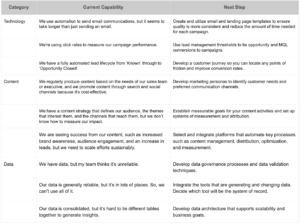How To Identify (And Accelerate) Your Marketing Maturity
In marketing, change happens fast. Throw in technology and the world seems to spin off a three-dimensional axis while being hurled through space.
So when we ask marketing directors and executives what their technology, content, and data priorities are for the year, we’re often met with a smile and a sigh.
Everyone knows what they want in the end:
A well-defined customer journey where marketing and sales activities are tied back to revenue, and where valuable customer insights are collected and used to advance opportunities and identify areas for improvement.
The challenge is in finding the pathway up the mountain in a quick enough time frame and at a pace you and your team can handle. When things are changing quickly and the world seems to be shifting beneath your feet, it’s hard to know where you are, let alone what’s next. (Not to mention there are now 6,829 platforms promising to be the solution to all your needs.)
At DemandLab, resolving this type of challenge is one of our favorite undertakings. Every organization has its strengths and weaknesses, and each one focuses on slightly different aspects of marketing and marketing operations. Trying to determine the right pathway for you and your team requires an overarching understanding of where you are now and where you need to go in the future.
This type of gap analysis examines the people, processes, and technologies that support your marketing efforts, and enables us to determine the factors that are constraining your growth. Then we can identify the next logical steps that will support your goals and offer the most return for your resource investment. So, if you’re headed for 10x growth, but every member of your sales operations team currently spends most of the day targeting and sending emails, it’s time to consider an ABM tool.
Here’s how we break down this enormous, nebulous task. We use a matrix tool to determine the organization’s maturity in three categories: technology, content, and data. These are the three integral elements of your marketing machine: technology to support your system of engagement, data is the fuel that flows through the system, and content is the core of the experience that you deliver.
This tool, which we call our marketing maturity model, uses success measures of all sizes as milestones and indicators to assess an organization’s maturity level. As an example, using campaign measures such as new leads collected, having a robust subscription preference center, or feeding a marketing data lake are all indicators for increasing levels of technology maturity. Using the maturity model as a gauge helps us to normalize the range and determine the ideal next step for a client, to ensure that they grow in a balanced fashion and additional marginal investments continue to see returns.
Technology, Content, and Data
When working with clients, we measure marketing maturity across a large number of indicators in these three categories, but for our stage-setting purposes here, we’re condensing our usual methods down to a 3×3 model: three levels across our three service areas. These are typical factors we look for when undertaking discovery as they help guide the direction of our inquiries and ultimately answer the question, ‘What’s the next step?’

If you identify with any of the maturity levels above, hopefully this gives you a starting point when deciding what to tackle next to take your marketing efforts to the next level. It’s important not only to advance each of these areas but to balance them at a similar level. Technology, content, and data need to work together to generate benefits at each level. A well-targeted campaign built on reliable data is unlikely to be successful without well thought out and targeted content.
If these challenges sound familiar and you’re ready to take 2019 by storm, we’d love to see how we can help.
